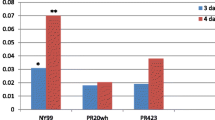Summary
A strain of Sindbis virus (SV), recently isolated from mosquitoes in Israel, was used as a source for variants which differ in neuroinvasiveness and virulence that were generated by serial passage of SV in suckling and weanling mouse brain. At the 15th passage a neurovirulent variant was observed and designated SVN (neurovirulent). After 7 more passages in weanling mouse brains, another variant was observed and designated SVNI (neuroinvasive) and both were isolated and purified. All strains caused similar viremia after intraperitoneal (I.P.) injection of weanling mice, but whereas SV was neuroinvasive but nonvirulent, SVN was neurovirulent but noninvasive and SVNI was both virulent and invasive. SVNI is the first SV variant which is both neurovirulent and neuroinvasive in weanling mice. Co-injection I.P. of SV+SVN resulted in presence of SV alone in the mouse brain; co-injection of SVNI+SVN resulted in full-titered replication of both strains in the brain. We assume that this is achieved through a breach of the blood brain barrier effected by SVNI replication and used by SVN for co-invasion. SV probably invades the brain by a different mechanism. I.P. infection with SVNI of inbred BALB/c mice gave rise to clinical signs only in a few mice even though substantial viremia was demonstrated.
Similar content being viewed by others
References
Akov Y (1976) Some properties of togavirus haemagglutinin studied with the aid of kaolin-adsorbed virus. Arch Virol 51: 99–106
Akov Y, Halevy M, Lustig S (1987) Neuroinvasiveness of west nile virus (WNV) strains and the use of modulators of the blood brain barrier (BBB). In: Proceedings of the 7th International Congress of Virology, Edmonton, Alberta, Canada, p 74
Chaturvedi UC, Khanna M, Dhawan R, Mathur A (1990) Dengue virus-induced cytokines increase capillary permeability. In: Proceedings of the 8th International Congress of Virology, Berlin, p 470
Clarke DH, Casals J (1958) Techniques for haemagglutination-inhibition with arthropod borne viruses. Am J Trop Med 7: 561–573
Gonzalez-Scarano F, Tyler KL (1987) Molecular pathogenesis of neurotropic viral infections. Ann Neurol 22: 565–574
Griffin DE (1986) Alphavirus pathogenesis and immunity. In: Schlesinger S, Schlesinger MJ (eds) The Togaviridae and Flaviviridae. Plenum, New York, pp 209–249
Griffin DE (1989) Molecular pathogenesis of sindbis virus encephalitis in experimental animals. Adv Virus Res 36: 255–257
Griffin DE, Johnson RT (1977) Role of the immune response in recovery from sindbis virus encephalitis in mice. J Immunol 118: 1070–1075
Griffin DE, Hahn SC, Jackson AC, Lustig S, Strauss EG, Strauss JH (1989) The basis of sindbis virus Neurovirulence. In: Compans R, Helenius A, Oldstone M (eds) Cell biology of virus entry, replication, and pathogenesis. AR Liss, New York, pp 387–396
Jackson AC, Moench TR, Trepp BD, Griffin DE (1988) Basis of neurovirulence in sindbis virus encephalomyelitis of mice. Lab Invest 58: 503–509
Johnson RT (1965) Virus invasion of the central nervous system: a study of sindbis virus infection in the mouse using fluorescent antibody. Am J Pathol 46: 929–943
Johnson RT (1982) Viral infection of the nervous system. Raven Press, New York
Johnson RT, Mims CA (1968) Pathogenesis of viral infections of the nervous system. New Engl J Med 278: 84–92
Kobiler D, Lustig S, Gozes Y, Ben-Nathan D, Akov Y (1989) Sodium dodecylsulphate induces a breach in the blood brain barrier and enables a west nile virus variant to penetrate into mouse brain. Brain Res 496: 314–316
Lustig S, Jackson AC, Hahn CG, Griffin DE, Strauss EG, Strauss JH (1988) Molecular basis of sindbis virus neurovirulence in mice. J Virol 62: 2329–2336
Monath TP, Cropp CB, Harrison AK (1983) Mode of entry of a neurotropic arbovirus into the central nervous system. Lab Invest 48: 399–410
Rapoport ST (1976) Blood-brain barrier in physiology and medicine. Raven Press, New York
Reed LJ, Muench H (1938) A simple method of estimating fifty percent end points. Am J Hyg 27: 493–497
Shahar A, Lustig S, Akov Y, David Y, Schneider P, Levin R (1990) Different pathogenicity of encephalitic togaviruses in organotypic cultures of spinal cord slices. J Neurosci Res 25: 345–352
Strauss EG, Rice CM, Strauss JH (1984) Complete nucleotide sequence of the genomic RNA of sindbis virus. Virology 133: 92–110
Taylor RM, Hurlbut HS, Work TH, Kingsbury RH, Frothingham TE (1955) Sindbis virus: a newly recognized arthropod-transmitted virus. Am J Trop Med Hyg 4: 844–846
Tyler KL, McPhee DA, Fields BN (1986) Distinct pathways of viral spread in the host determined by reovirus S1 gene segment. Science 233: 770–774
Author information
Authors and Affiliations
Rights and permissions
About this article
Cite this article
Lustig, S., Halevy, M., Ben-Nathan, D. et al. A novel variant of Sindbis virus is both neurovirulent and neuroinvasive in adult mice. Archives of Virology 122, 237–248 (1992). https://doi.org/10.1007/BF01317186
Received:
Accepted:
Issue Date:
DOI: https://doi.org/10.1007/BF01317186




